The Importance of Knowing How to Handle Brake Failure
Brake failure is a terrifying and potentially life-threatening situation for any driver. Knowing how to handle this emergency can make a significant difference in the outcome, potentially preventing accidents and saving lives. This article will explore the common causes of brake failure and provide step-by-step instructions for handling a brake failure situation while driving.

Common Causes of Brake Failure: Recognizing the Risks
Worn-out brake pads or shoes
One of the most common causes of brake failure is the wearing out of brake pads or shoes. Over time, the friction material on these components wears thin, reducing their effectiveness and increasing the risk of brake failure. Regularly inspecting and replacing worn brake pads or shoes is essential for maintaining optimal braking performance and preventing brake failure.
Leaking or contaminated brake fluid
Another common cause of brake failure is leaking or contaminated brake fluid. Brake fluid is essential for transmitting the pressure from the brake pedal to the brake calipers or wheel cylinders, which then apply the brakes. If the brake fluid is leaking or contaminated with water, dirt, or other substances, it can cause a loss of hydraulic pressure, leading to brake failure.
Faulty brake lines or hoses
Brake lines and hoses are responsible for carrying the brake fluid from the master cylinder to the brake calipers or wheel cylinders. Damaged or corroded brake lines can result in fluid leaks or blockages, preventing the necessary hydraulic pressure from reaching the brakes. This can ultimately lead to brake failure. Inspecting and replacing damaged brake lines and hoses is essential for maintaining a reliable braking system.
Malfunctioning brake booster or master cylinder
The brake booster and master cylinder are crucial components of the braking system, responsible for amplifying the force applied to the brake pedal and transferring it to the brake fluid. If either of these components malfunctions, the braking system can lose pressure, leading to brake failure. Regularly inspecting and servicing these components can help prevent this issue.
Overheating brake components
Overheating brake components, such as the brake pads, rotors, or calipers, can lead to brake failure. Overheating can be caused by excessive braking, particularly during high-speed driving or when descending steep hills. It can also result from dragging brakes due to a stuck caliper or improperly adjusted brake shoes. To prevent overheating, ensure that your braking system is in good condition and avoid excessive braking when possible.
Initial Steps: Staying Calm and Focused During a Brake Failure
When you first realize your brakes have failed, it’s essential to remain calm and focused. Panic can cause you to make poor decisions and potentially worsen the situation. Take a deep breath and follow these steps to safely navigate through brake failure:
1. Turn on your hazard lights to signal other drivers of your emergency.
2. Remove your foot from the gas pedal to reduce speed naturally.
3. Keep both hands on the steering wheel to maintain control of your vehicle.
Pumping the Brake Pedal: A First Response to Brake Failure
If your brakes fail, try pumping the brake pedal rapidly. This action can help build up pressure in the brake lines and may restore some braking function, allowing you to slow down your vehicle.
Using the Emergency Brake: An Alternative Solution
If pumping the brake pedal doesn’t work, use the emergency brake (also known as the parking brake) to help slow down your vehicle. Apply it slowly and steadily to avoid locking the wheels and causing a skid.
Downshifting Gears: How It Can Help Slow Down Your Vehicle
Downshifting gears can help reduce your vehicle’s speed if the brakes fail. If you have a manual transmission, downshift one gear at a time, allowing the engine to slow the vehicle. For automatic transmissions, shift into a lower gear or use the “L” (Low) setting if available.
Navigating Traffic Safely: Avoiding Collisions in a Brake Failure Situation
As you work to slow down your vehicle, remain aware of your surroundings and other vehicles. Use your turn signals and horn to alert others of your situation, and try to avoid sudden maneuvers that could cause an accident.
Finding a Safe Place to Stop: Assessing Your Options
Once your vehicle has slowed down significantly, look for a safe place to bring it to a complete stop. This could be a shoulder, an exit ramp, or a level area off the road. Avoid stopping on hills, curves, or in areas with limited visibility.
Calling for Assistance: When to Contact a Tow Truck or Emergency Services
After bringing your vehicle to a safe stop, turn off the engine and call for assistance. Depending on the severity of the situation, you may need a tow truck, a mechanic, or emergency services.

Preventing Brake Failure: Regular Maintenance and Inspection Tips
To minimize the risk of brake failure:
1. Regularly inspect your brake system, including brake pads, shoes, fluid, and lines.
2. Schedule routine maintenance and follow your vehicle manufacturer’s recommendations.
3. Address any brake-related issues promptly.
Conclusion: Be Prepared for Brake Failure to Stay Safe on the Road
Brake failure is a dangerous and frightening experience, but knowing how to handle it can help you stay safe and minimize potential damage. Familiarize yourself with these steps, practice regular brake maintenance, and be prepared to act calmly and decisively in the event of a brake failure.
